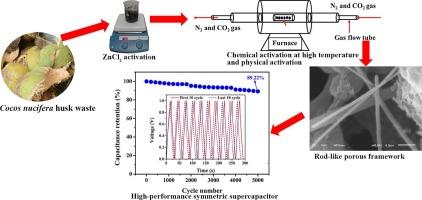Biomass-derived oxygen-rich activated carbon with a rod-like porous structure for use in electrochemical energy storage devices
IF 5.1
3区 材料科学
Q2 MATERIALS SCIENCE, COATINGS & FILMS
引用次数: 0
Abstract
In recent years, heteroatom-doped activated carbon has gained significant attention in the field of electrochemical energy storage owing to its advantageous characteristics. This study involved the creation of self‑oxygen-doped active carbon through an easy preparation technique from Cocos nucifera husk waste via a one-step physicochemical activation strategy. The resulting O self-doped AC possesses a rod-like porous framework, an abundant O content (6.24 wt%), and a high specific surface area (480 m2 g−1). At a current rate of 1 A g−1, the specific capacitance of CNHAC-2.5 has reached a remarkable value as high as 280 F g−1. This device also delivered a high specific energy of 38.84 Wh kg−1 at a specific power of 207.47 W kg−1. These findings indicate that the Cocos nucifera husk waste has potential for use as a precursor for self‑oxygen-doped activated carbon, which can be used as an electrode material for SCs, offering cost-effectiveness and superior performance.

具有棒状多孔结构的生物质衍生富氧活性炭,用于电化学储能装置
近年来,杂原子掺杂活性炭以其优越的特性在电化学储能领域受到了广泛的关注。本研究以椰壳废料为原料,采用一步物理化学活化的方法制备了自氧掺杂活性炭。由此得到的O自掺杂AC具有棒状多孔框架,丰富的O含量(6.24 wt%)和高比表面积(480 m2 g−1)。在1 a g−1的电流速率下,CNHAC-2.5的比电容达到了280f g−1的显著值。在207.47 W kg−1的比功率下,该器件还提供了38.84 Wh kg−1的高比能。这些发现表明,椰果壳废弃物具有作为自氧掺杂活性炭前驱体的潜力,可作为SCs的电极材料,具有成本效益和优越的性能。
本文章由计算机程序翻译,如有差异,请以英文原文为准。
求助全文
约1分钟内获得全文
求助全文
来源期刊

Diamond and Related Materials
工程技术-材料科学:综合
CiteScore
6.00
自引率
14.60%
发文量
702
审稿时长
2.1 months
期刊介绍:
DRM is a leading international journal that publishes new fundamental and applied research on all forms of diamond, the integration of diamond with other advanced materials and development of technologies exploiting diamond. The synthesis, characterization and processing of single crystal diamond, polycrystalline films, nanodiamond powders and heterostructures with other advanced materials are encouraged topics for technical and review articles. In addition to diamond, the journal publishes manuscripts on the synthesis, characterization and application of other related materials including diamond-like carbons, carbon nanotubes, graphene, and boron and carbon nitrides. Articles are sought on the chemical functionalization of diamond and related materials as well as their use in electrochemistry, energy storage and conversion, chemical and biological sensing, imaging, thermal management, photonic and quantum applications, electron emission and electronic devices.
The International Conference on Diamond and Carbon Materials has evolved into the largest and most well attended forum in the field of diamond, providing a forum to showcase the latest results in the science and technology of diamond and other carbon materials such as carbon nanotubes, graphene, and diamond-like carbon. Run annually in association with Diamond and Related Materials the conference provides junior and established researchers the opportunity to exchange the latest results ranging from fundamental physical and chemical concepts to applied research focusing on the next generation carbon-based devices.
 求助内容:
求助内容: 应助结果提醒方式:
应助结果提醒方式:


